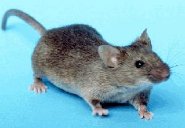 The house mouse (Mus musculus) is the mouse that immediately springs to mind whenever anyone says the word "mouse." Thousands of years ago, the house mouse discovered that humans left a lot of edible trash. They lived close to humans, even before humans built houses. The house mouse has successfully stowed away on boats to colonize other countries.
The house mouse (Mus musculus) is the mouse that immediately springs to mind whenever anyone says the word "mouse." Thousands of years ago, the house mouse discovered that humans left a lot of edible trash. They lived close to humans, even before humans built houses. The house mouse has successfully stowed away on boats to colonize other countries.The house mouse is thought to have originated in the Mediterranean, spread to China and from there dispersed with humans to every continent in the world except Antarctica. This is not an endangered species. Humans treat the house mouse as a pest and spend a great deal of money to exterminate them. The house mouse is a great dinner for many predators, including domestic cats, dogs, owls, hawks, wolves, foxes, weasels, mongooses and large reptiles.
Physical Description
The house mouse possesses a small, compact lightly furry body that is able to squeeze into very tight spaces. Coloration varies from grey to brown to agouti – a mixture of brown and black. The underside is a pale color. The small feet and long tail are naked or very, very lightly covered in fur that cannot be seen from a short distance. The house mouse has a shorter pointed face than that of a rat or a shrew.
Life Cycle and Behavior
The house mouse is like a human in that it can breed at any time and not during one particular season. The mother can produce litters up to a dozen babies, although litters average only 5 to 7 babies. After a three week gestation, the babies are born hairless, blind and deaf. The female house mouse has five sets of nipples which can accommodate such large litters. After three weeks, the babies are weaned and on their own. The mother mouse is ready to mate again.
House mice are flexible socially in that they can live singly or in large groups. House mice can eat just any food available to them, including soap, plastic and dead mice.
Keywords: tail
The House mouse is listed as Least Concern (LR/lc), lowest risk. Does not qualify for a more at risk category. Widespread and abundant taxa are included in this category, on the IUCN Red List of Threatened Species
Namings for the house mouse
A young / baby of a house mouse is called a 'pinkie, kitten or pup'. The females are called 'doe' and males 'buck'. A house mouse group is called a 'nest, colony, harvest, horde or mischief'.Some facts about the
House mouse
Adult weight : 0.021 kg (0.0462 lbs)
Maximum longevity : 4 years
Female maturity :42 days
Male maturity : 42 days
Gestation : 19 days
Weaning : 22 days
Litter size : 7
Litters per year : 5
Interval between litters : 30 days
Weight at birth : 0.001 kg (0.0022 lbs)
Weight at weaning : 0.009 kg (0.0198 lbs)
Body mass : 0.018 kg (0.0396 lbs)

Custom Search